Research Highlights
Quantum Materials
Graphene-based Electronics
Unconventional Nanofabrication Technique
Armed with a state-of-art
dilution fridge system, we are capable of performing transport measurement in
extreme conditions at temperature as low as 15 mK and magnetic field up to 17
Tesla where new phenomena and new physics can be revealed. The systems currently
under investigation are complex oxide systems, strongly correlated electronic
systems,
topological insulator...etc.
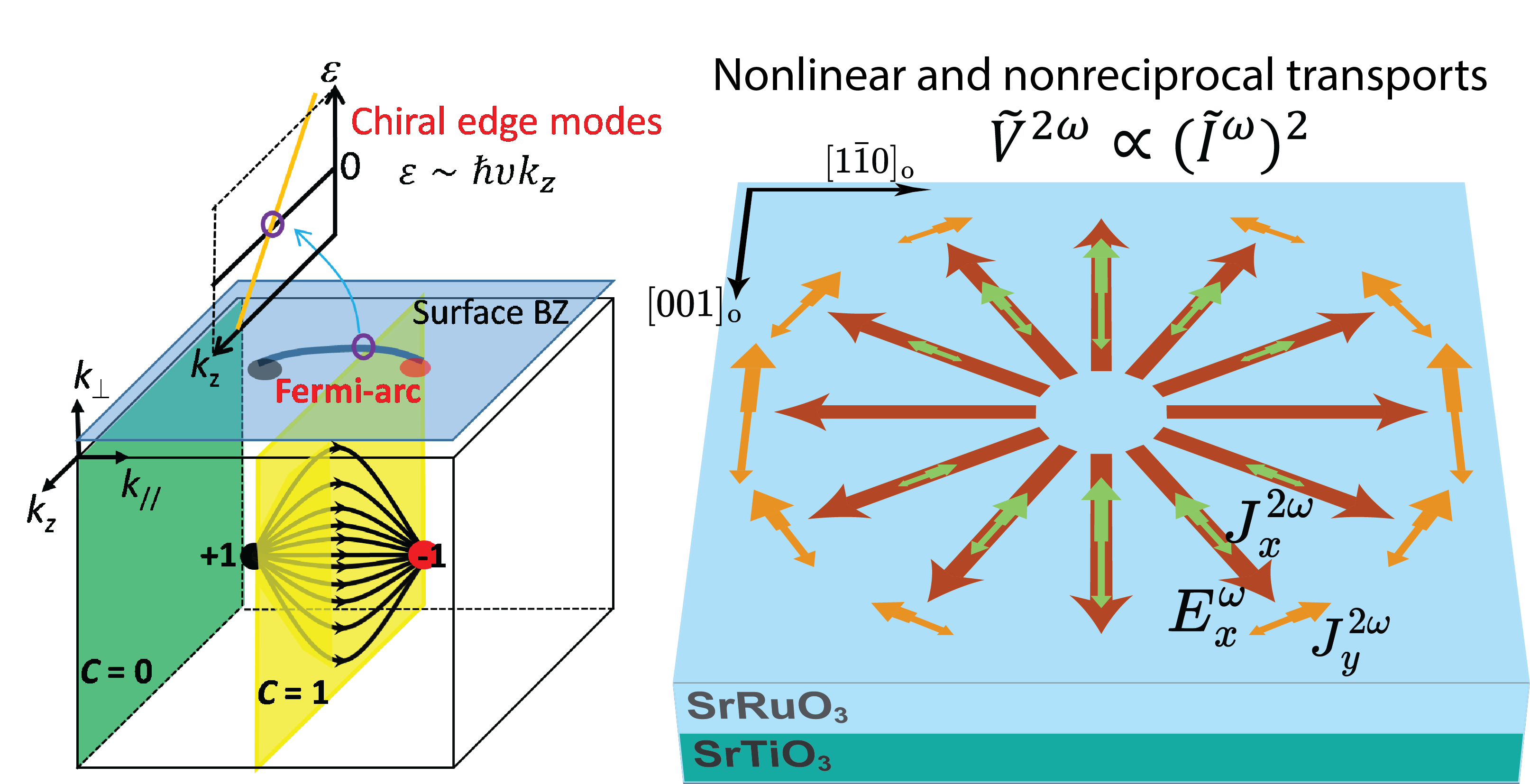 “ Nonlinear and nonreciprocal transport effects in untwinned thin films of ferromagnetic Weyl metal SrRuO3”,
Phys. Rev. X 14, 011022(2024). “ Nonlinear and nonreciprocal transport effects in untwinned thin films of ferromagnetic Weyl metal SrRuO3”,
Phys. Rev. X 14, 011022(2024).
|
Revealing topological surface states via nonlinear and nonreciprocal transport effects:
One of the challenging subjects in topological
systems is to identify the charge transport signatures associated with the
unusual surface states due to nontrivial band topology. In a recent
international collaborating work led by Dr. Wei-Li Lee and Prof. Guang-Yu
Guo, an unusual large nonreciprocal and nonlinear charge transport effects
(NRTE) in both longitudinal and transverse channels were observed in thin
films of topological ferromagnetic Weyl metal SrRuO3 (SRO). These
behaviors align with a proposed scenario of an effective Berry curvature
dipole originating from Fermi-arc surface states accompanied by 1D chiral
edge modes, which is supported by electronic band structure calculations.
Our findings not only highlight the significance of NRTE as a charge
transport probe for topological surface states with a broken inversion
symmetry but also feature potential applications in nonreciprocal
electronics and nonlinear optics using topological materials. The complete
data and analyses have been recently accepted for publication at Physical
Review X. Uddipta kar, Elisha Lu, Akhilesh Singh and P.V. Sreenivasa Reddy
are the co-first authors. The SRO thin film growth, device fabrication and
transport measurements were carried out by Dr. Wei-Li Lee’s group at IoPAS
and Prof. I-Chun Cheng’s group at NTU. The electronic band structure
calculations were performed by Prof. Guan-Yu Guo’s group at NTU and Prof.
Wei-Cheng Lee’s group at SUNY Binghamton. The optical SHG measurements
were performed by Prof. David Hsieh’s group at Caltech. The SRO thin film
structural characterizations were performed by Director Chia-Hung Hsu’s
group at NSRRC.
|
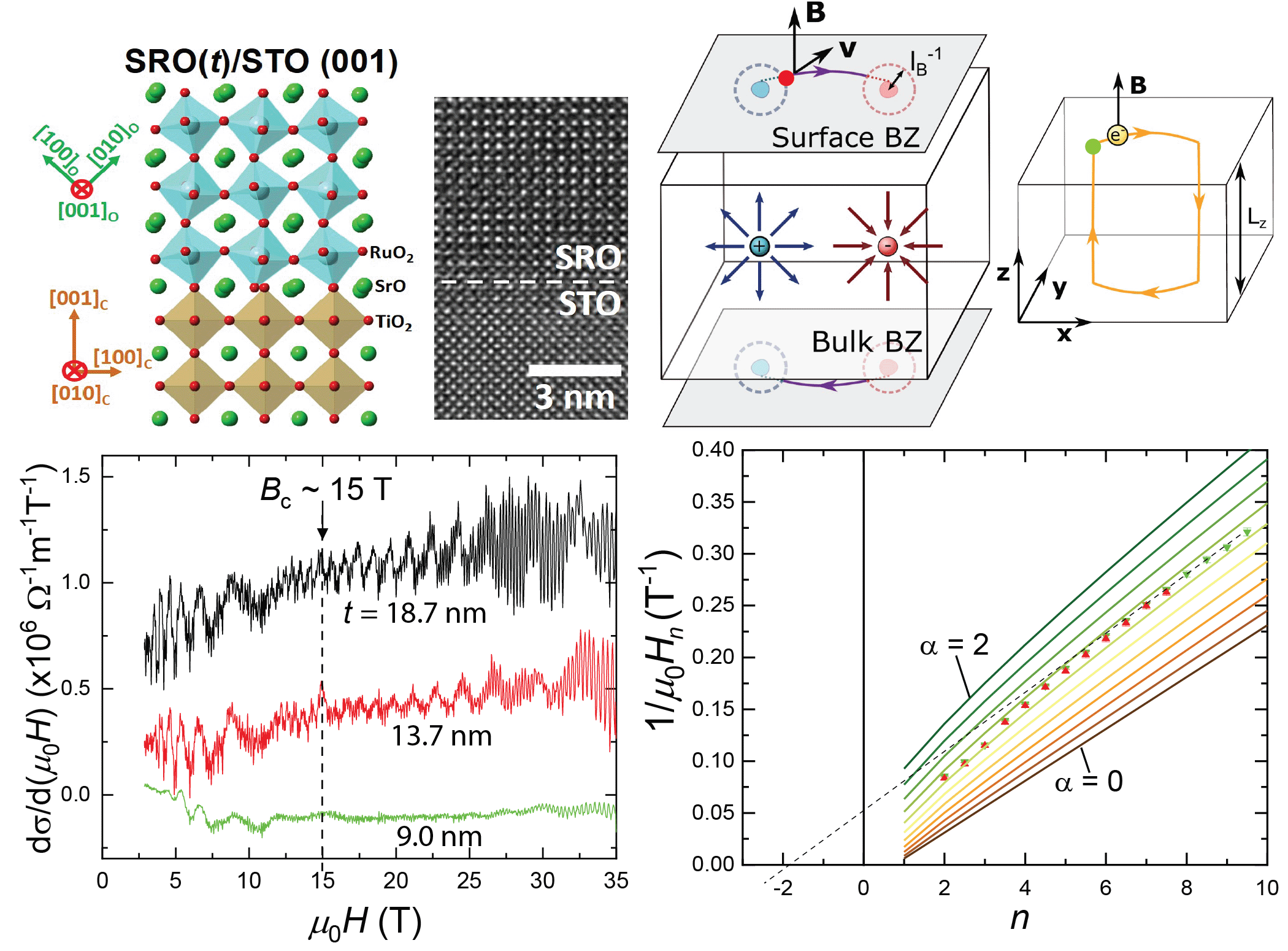 “The thickness dependence of quantum oscillations in ferromagnetic Weyl metal SrRuO3”,
npj Quantum Materials 8, 8(2023). “The thickness dependence of quantum oscillations in ferromagnetic Weyl metal SrRuO3”,
npj Quantum Materials 8, 8(2023).
(Blog)
|
A glimpse of Weyl-orbit quantum oscillations in Weyl metal SrRuO3: In a topological Weyl semimetal, the correspondence between bulk Weyl nodes and surface Fermi-arc states gives rise to a unique nonlocal cyclotron motion via the electron tunnelings between the top and bottom Fermi-arc
surface states, which was referred to as the Weyl-orbit effect exhibiting an unusual thickness dependent quantum oscillations. In an international collaboration led by Dr. Wei-Li Lee’s group, such an unusual thickness dependent Weyl-orbit quantum oscillation was
demonstrated in untwinned Weyl metal thin films of SrRuO3 grown by oxide molecular beam epitaxy facility at IoPAS. The quantum oscillations measurements with field up to 35 T were carried out at EMFL-Nijmegen in Netherlands in collaboration with Prof. Steffen Wiedmann’s
group, and the rigorous band calculations were done by Prof. Wei-Cheng Lee’s group at SUNY Binghamton in USA. The high precision X-ray characterizations were performed at the NSRRC, Hsinchu in Taiwan in collaboration with Director Chia-Hung Hsu‘s group.
The complete data and analyses have been recently published online at npj Quantum Materials (https://rdcu.be/c31ub). Uddipta Kar and Dr. Akhilesh Singh are the first two authors with equal contributions and responsible for the quantum oscillation data analyses
and also the growths and structural characterizations of the SrRuO3 thin films.
|
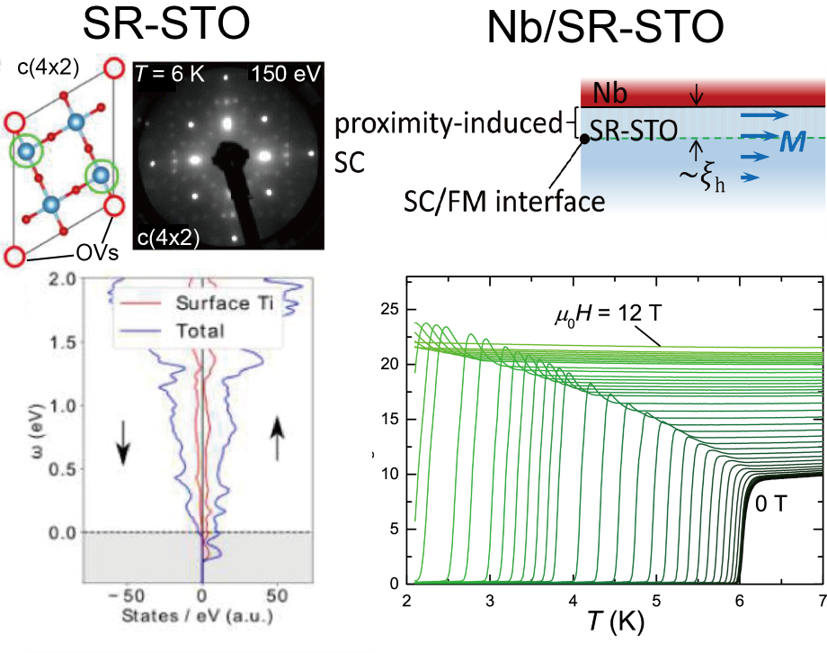 “Field-induced
resistance peak in a superconducting niobium thin film proximity coupled
to a surface reconstructed SrTiO3”,
npj Quantum Materials 5,
45(2020). “Field-induced
resistance peak in a superconducting niobium thin film proximity coupled
to a surface reconstructed SrTiO3”,
npj Quantum Materials 5,
45(2020).
|
Revelation of the exotic electronic states in surface-reconstructed
SrTiO3: Oxygen vacancies (OVs) on the
surface of a wide band-gap SrTiO3 (STO) were known to induce surface
reconstructions (SR), which not only resulted in electron dopings but also
was theoretically predicted to show magnetism with unusual spin-polarized
in-gap states. Experimental confirmations for those exotic states are
hampered by the difficulty of maintaining such surface structures under
ambient conditions. In a recent collaborating work led by Dr. Wei-Li Lee
at IoPAS and Prof. Wei-Cheng Lee at Binghamton University SUNY, such
exotic electronic states in SR-STO were revealed by proximity coupling a
superconductor (SC), serving as a probe and also a protection layer, to a
SR-STO. Dr. Akhilesh Singh and Uddipta Kar, who are the first and the
second authors of the paper, utilized the interconnected multi-UHV
chambers facility at IoPAS. The SR-STO was prepared and characterized via
electron diffraction under UHV followed by UHV deposition of
superconducting niobium (Nb) thin films to ensure a clean interface
between SC and SR-STO. An unusual and generic field-induced peak
resistance effect was uncovered for the first time in such a hybrid
SC/SR-STO system. Combining magnetization measurements and also detailed
DFT calculations, we proposed a model based on the interface resistance
between a SC and a highly spin-polarized metal that gives a
self-consistent explanation to the observed field-induced peak resistance
effect. Our results strongly support for the existence of spin-polarized
in-gap states in SR-STO.
|
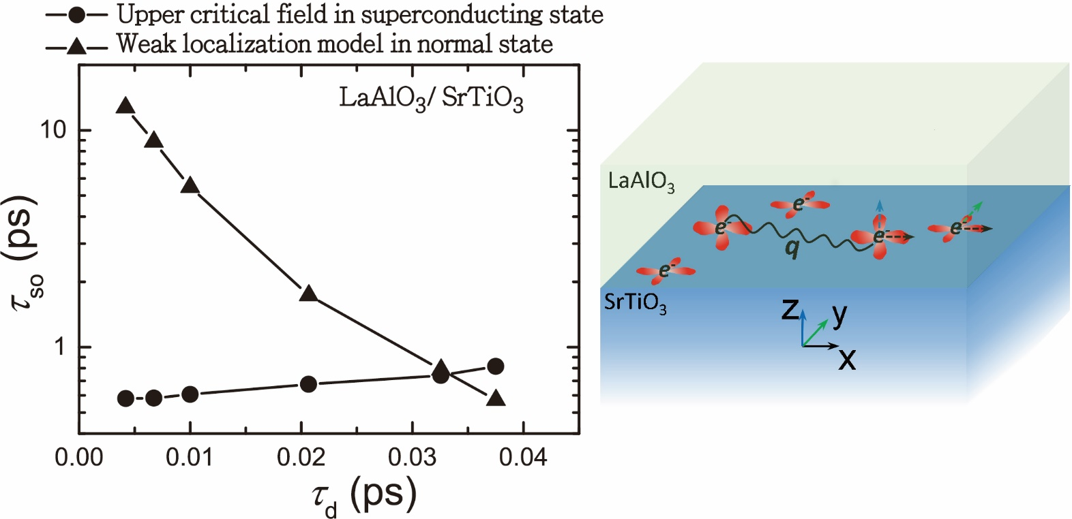 “Determination of spin-orbit scattering lifetime at the interface of
LaAlO3/SrTiO3 from the superconducting upper critical fields”,
Phys. Rev.
Research 2, 013311 (2020). “Determination of spin-orbit scattering lifetime at the interface of
LaAlO3/SrTiO3 from the superconducting upper critical fields”,
Phys. Rev.
Research 2, 013311 (2020).
|
Electronic phase separation for the interface
superconductivity in LaAlO3/SrTiO3:
The formation of Cooper pairs can be more favorable for electrons from certain
orbitals, giving rise to an unusual state with the coexistence of normal fluid and
superfluid. Such a phase
is likely to happen for the interface superconductivity in LaAlO3/SrTiO3. The
orbital nature of an electron largely affects its spin-orbit interaction, which can be
determined independently either from the weak-localization model in normal
state or from the upper critical fields in superconducting state. We have
developed a practical scheme to extract spin-orbit parameters from upper critical
fields for low transition temperature superconducting systems with strong spinorbit
coupling. A striking discrepancy in the extracted spin-orbit coupling
parameters was uncovered for the first time in high quality LaAlO3/SrTiO3 samples grown by oxide molecular beam epitaxy technique, indicating a
difference in the spin-relaxation mechanism for the charge transport above and
below the superconducting transition temperature. Such a finding supports for a
possible orbital selectivity for the Cooper pairing and thus an electronic phase
separation at the interface of LaAlO3/SrTiO3 that may shed some lights toward
understanding the exotic low-density superconductivity.
|
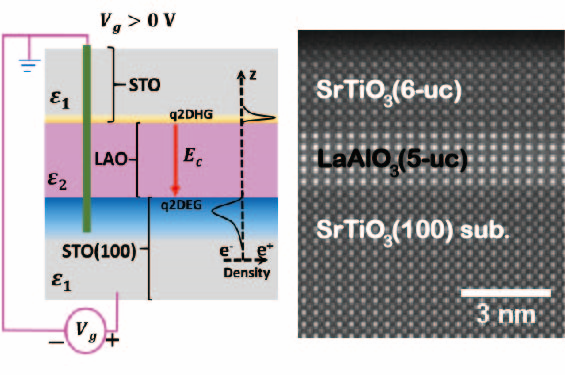
"Influence of SrTiO3 capping layer on the charge transport at the interfaces of SrTiO3/LaAlO3/SrTiO3 (100) heterostructure",
Phys. Rev. Materials 2, 114009 (2018). |
The existence of quasi-two-dimensional hole gas at complex oxide interface:
A number of discoveries have
been made for the quasi-two-dimensional electron gas (q2DEG) at the
complex oxide interface systems, but the possibility of a
quasi-two-dimensional hole gas (q2DHG) at complex oxide interface and its
experimental confirmation remain debatable.High quality ultra-thin
epitaxial oxide films were grown and characterized by an oxide molecular
beam epitaxy facility at IoP. Electric gated devices based on
SrTiO3(6-uc)/LaAlO3(5-uc)/SrTiO3 (100) were then fabricated to further
tune the interface conducting channels. From complete low-temperature
magneto-transport measurements with a gate voltage tuning, the data were
analyzed and fitted rigorously using the two-band transport model, which
confirms the existence of such a q2DHG at oxide interface. The existence
of both electrons and holes has enriched the functionality for
semiconductor-based devices in the past. The existence of q2DHG at complex
oxide interface not only largely extends the scope for complex oxide
electronics but also provides a new platform for exploring new fundamental
physical phenomena in matter.
|
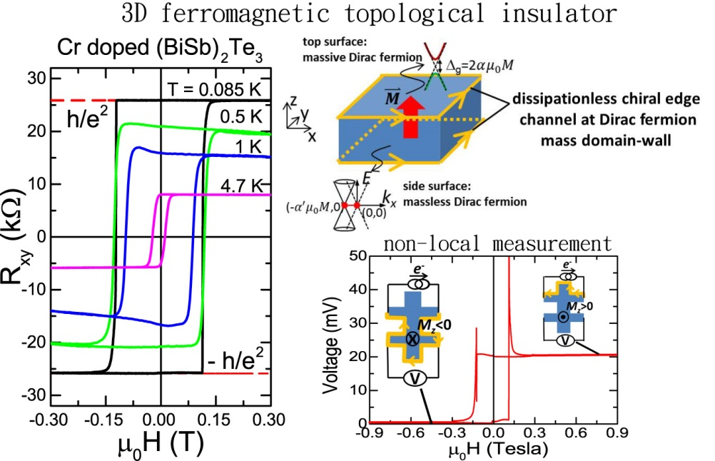
"Scale-Invariant
Quantum Anomalous Hall Effect in Magnetic Topological Insulators beyond
the Two-Dimensional Limit",
Phys. Rev. Lett. 113, 137201 (2014). |
Demonstration of robust quantum anomalous Hall
effect (QAHE) in macroscopic and 3D ferromagnetic topological insulator
system: Anomalous Hall effect refers to the phenomenon of linear proportionality
between the anomalous Hall resistance and its magnetic moment in a
magnetic system. In normal magnetic metal and semiconductor,
there is no universal value for the anomalous Hall resistance.
Nevertheless, in a ferromagnetic topological insulator (FM TI) under zero
external magnetic field, the Dirac surface states, originating from the
non-trivial bulk band topology,
attain different effective masses on different surfaces. This results in a
dissipationless chiral edge channel forming at the Dirac fermion mass
domain-wall and gives rise to the quantization of the anomalous Hall
resistance.This effect was now further demonstrated in a macroscopic and
3D FM TI. This may provide a new direction for resolving the heat
dissipation problem in electronics using dissipationless chiral edge
channel in a topological material.
|
Graphene comprises a single atomic layer of carbon sheet. In its honeycomb
lattice structure, electron loses all its mass traveling at a speed of 300 times
smaller than c (the speed of light) obeying Dirac equation. Even though electron becomes massive in a
bi-layer graphene, the chiral fermionic excitations remain present in both single-layer
and bi-layer graphene. There are two well-defined values of "chirality"(projection
of pseudo-spin state on the propagation direction) resembling the "helicity" in
particle physics but not only being limited to massless particles. Many novel
transport phenomena have been reported, where the chiral fermionic property
plays an important role. In addition, graphene-based electronics may be a
promising candidate for the next generation electronics.
We have developed a
scheme to prepare micron-sized few-layer graphene crystals.
We are working on several other graphene-based device to
further explore the special transport phenomena resulting from the chiral
fermions.
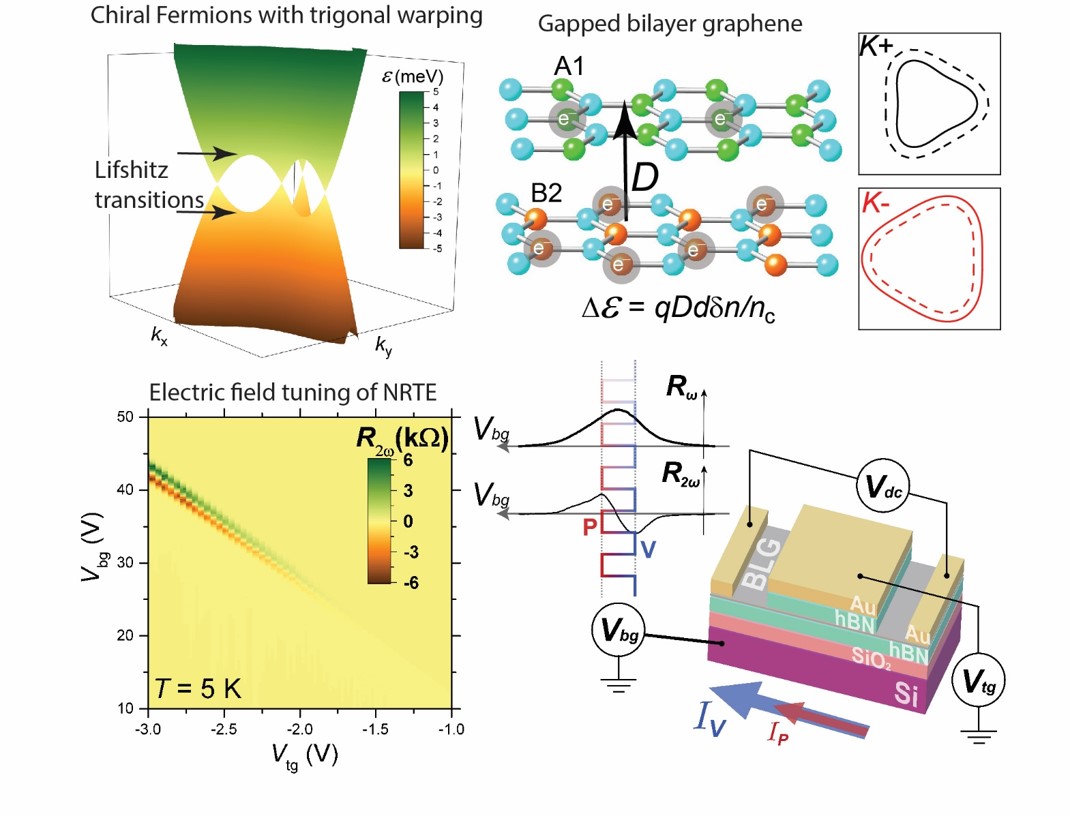 “Full
electric field tuning of the nonreciprocal and nonlinear charge transport
in massive chiral Fermions with trigonal warping”,
Physical Review Research
3, 033160
(2021). “Full
electric field tuning of the nonreciprocal and nonlinear charge transport
in massive chiral Fermions with trigonal warping”,
Physical Review Research
3, 033160
(2021).
|
Full electric field tuning of the nonreciprocal and nonlinear charge
transport in massive chiral Fermions with trigonal warping:
Recently, there are a number of interests for the non-reciprocal transport
effect (NRTE) in non-centrosymmetric systems that may realize an
intriguing possibility of current rectification via a single-phase
material. Most of the reported single-phase systems with NRTE require a
finite external magnetic field owing to the magneto-electric anisotropy
term in the form of k∙E×B.
Here,
a
full electric-field tuning of NRTE in dual-gated bilayer
graphene (BLG)
device was demonstrated in the absence of magnetic field,
which originates from the unique massive
chiral fermions with trigonal warping in a gapped BLG.
The magnitude of NRTE is at maximum when the Fermi surface undergoes a
Lifshitz transition near the band edges. Our
findings may open up a new direction for
the emerging fields of “valleytronics”
and “twistronics”.
|
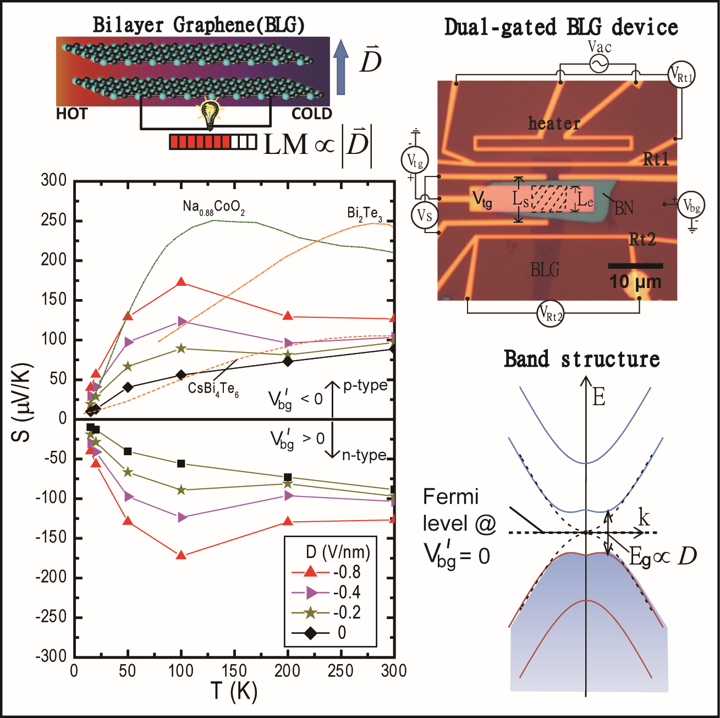
"Enhanced Thermoelectric Power in Dual-Gated
Bilayer Graphene",
Phys.
Rev. Lett. 107, 186602 (2011).
|
Enhanced Thermoelectric Power in Dual-Gated Bilayer Graphene:
The “field-effect thermoelectricity” is
demonstrated for the first time in experiment. When applying a
perpendicular electric field (D) on a bilayer graphene, the thermoelectric
power (TEP) can be amplified more than 4 folds while the carrier density
remains the same. The value of TEP is comparable to or exceeding several
known low temperature thermoelectric materials. The physical mechanism is
rooted in the band-gap opening due to the inversion symmetry breaking by
D, which largely increases the band curvature near the band edges. On the
other hand, its polarity can be readily tuned by the gate voltage to be
either electron-type or hole-type. Our results open up a new possibility
in thermoelectric application using graphene-based device.
|
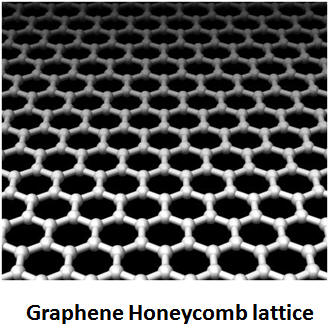
|
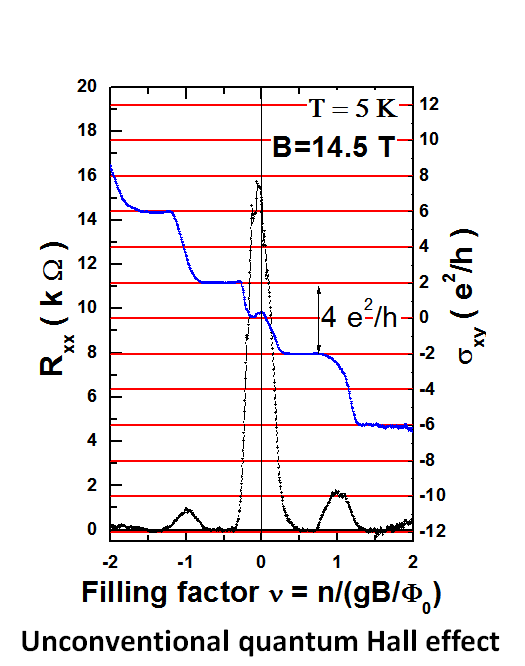
|
In
conventional nanofabrication tools, resist and chemicals are needed and may
degrade the quality of deposited thin film. We, therefore, intend to develop a
technique for resist-free fabrication of nano-device such that the quality of thin films and also interfaces
can be improved. This would be important for the study in spin-electronics devices.
We have developed a technique to fabricate large area periodic nanostructured system
at lower cost and better time efficiency. We utilized a special polymer bridging
effect to prepare large area (more than 1 cm x 1 cm) monolayer of close-packed
polystyrene nanospheres with various diameter ranging from 100 nm to 1um.
It can then be used as a template to fabricate large area nanostructured system.
From a series of cobalt antidot thin film samples prepared by this technique, we
found an interesting crossover behavior in the magnitization reversal when
tuning the antidot diameters. In addition, we also uncovered that the effective
moment per cobalt atom is marching down as the surface to bulk volume fraction
increases.
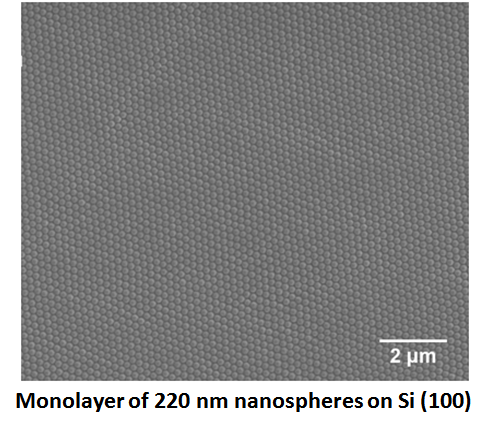
|
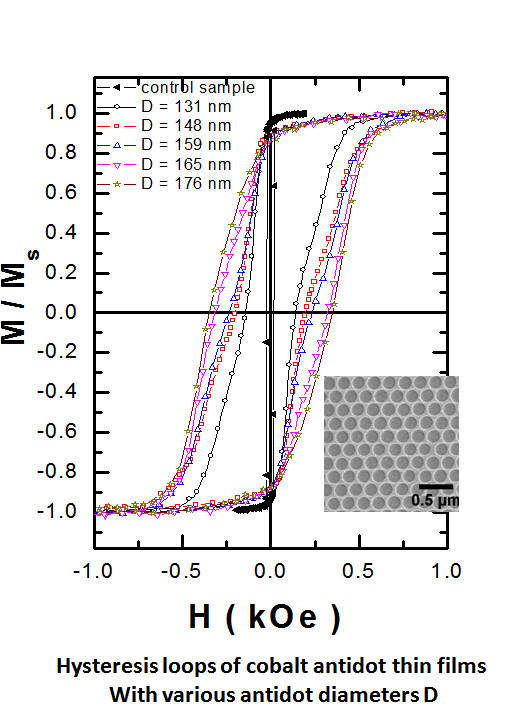
|
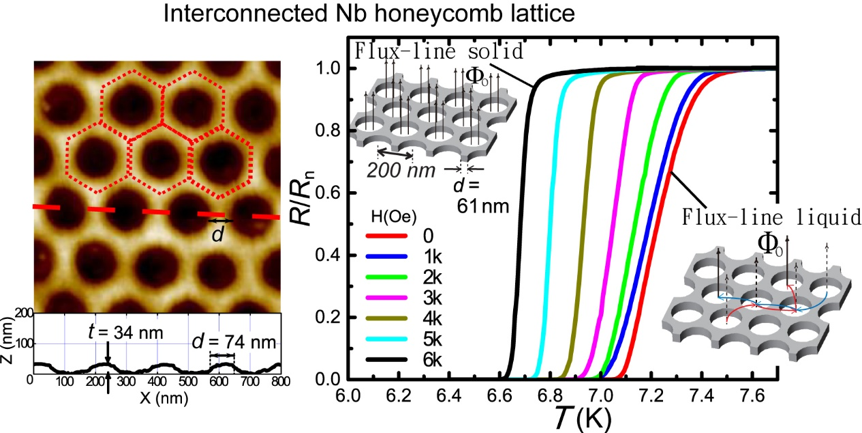
"Evidence for
enhanced phase fluctuations in nanostructured niobium thin films",
Phys.
Rev. B 96, 020506(R) (2018). |
Enhanced superconducting phase fluctuation via artificial nanostructure
engineering: In a conventional superconductor, a large
Cooper pair density gives rise to a extremely stiff phase rigidity, thus
obscuring the rich phenomena associated with phase fluctuations. The phase
rigidity in superconducting niobium (Nb) films can be effectively reduced
by imposing well-ordered anti-dots, forming a interconnected Nb honeycomb
lattice (INHL). By using a special technique we developed previously, the
first author, Ms. Ting-Hui Chen, succeeded in fabricating a remarkable
series of INHLs with sub-100nm nanostructures extending over 108
cells and up to few millimeters in size, where an unusual superconducting
transition width narrowing in fields was observed for the first time in
superconducting systems. The broadened transition width in zero field is a
direct consequence of the enhanced phase fluctuations due to the
intriguing interplay between the phase slips and flux-line lattice. Our
works demonstrate the feasibility of reducing the phase rigidity in a
superconductor via artificial nanostructure engineering.
|
More highlights:
Fabrication of
monolayer polymer/nanosphere hybrid at a water-air interface
Top
 “ Nonlinear and nonreciprocal transport effects in untwinned thin films of ferromagnetic Weyl metal SrRuO3”,
Phys. Rev. X 14, 011022(2024).
“ Nonlinear and nonreciprocal transport effects in untwinned thin films of ferromagnetic Weyl metal SrRuO3”,
Phys. Rev. X 14, 011022(2024). “The thickness dependence of quantum oscillations in ferromagnetic Weyl metal SrRuO3”,
“The thickness dependence of quantum oscillations in ferromagnetic Weyl metal SrRuO3”,  “Field-induced
resistance peak in a superconducting niobium thin film proximity coupled
to a surface reconstructed SrTiO3”,
“Field-induced
resistance peak in a superconducting niobium thin film proximity coupled
to a surface reconstructed SrTiO3”,  “Determination of spin-orbit scattering lifetime at the interface of
LaAlO3/SrTiO3 from the superconducting upper critical fields”,
“Determination of spin-orbit scattering lifetime at the interface of
LaAlO3/SrTiO3 from the superconducting upper critical fields”, 

 “Full
electric field tuning of the nonreciprocal and nonlinear charge transport
in massive chiral Fermions with trigonal warping”,
“Full
electric field tuning of the nonreciprocal and nonlinear charge transport
in massive chiral Fermions with trigonal warping”,





